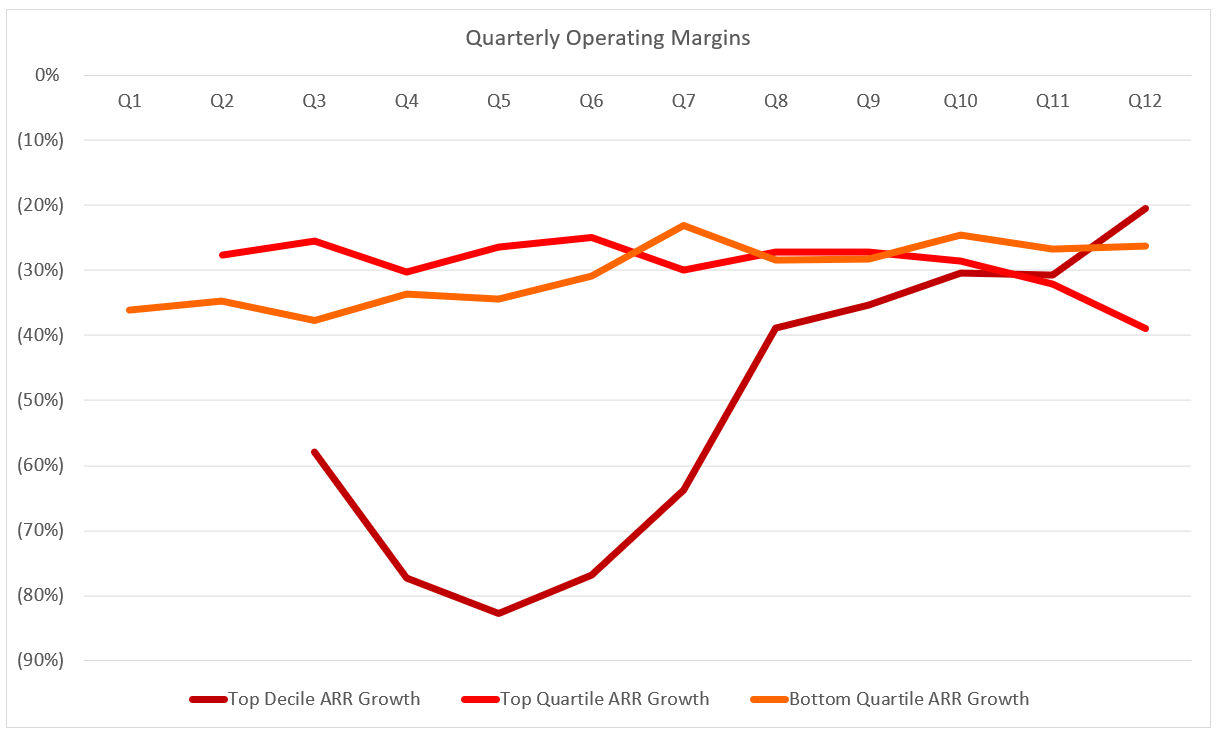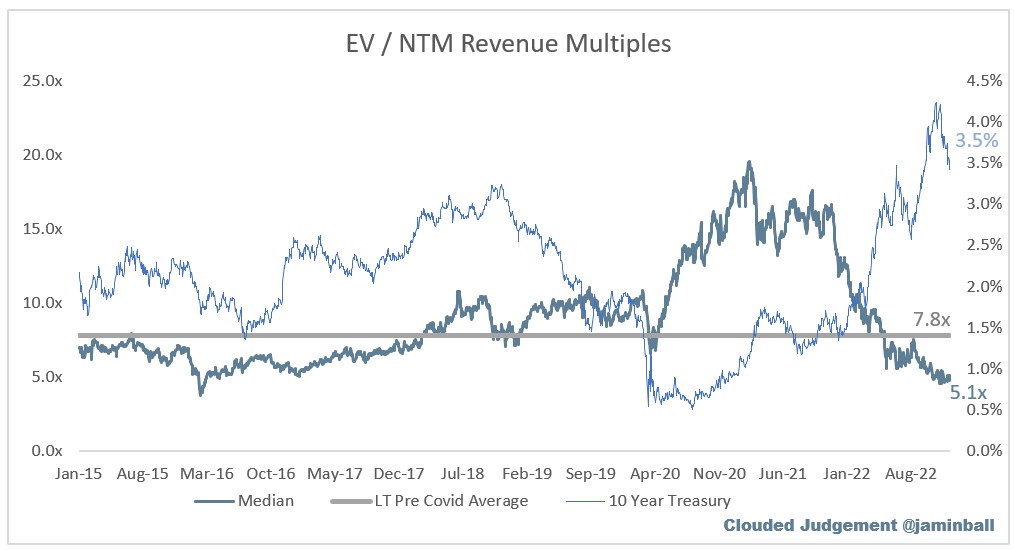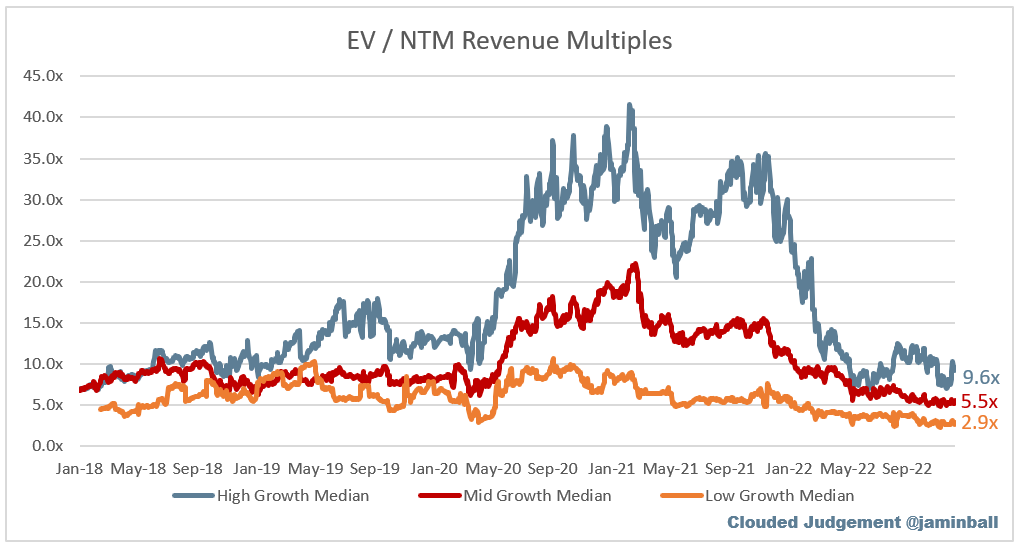Clouded Judgement 12.9.22
Every week I’ll provide updates on the latest trends in cloud software companies. Follow along to stay up to date!
Can High Growth Businesses Become Profitable?
I went back and looked at the last ~50 software IPOs and benchmarked them across a number of metrics. One chart I found interesting was tracking how each business grew from the time they hit ~$75m ARR. The below chart shows the top decile, top quartile, and bottom quartile ARR growth, where Q1 represents the first quarter each company was ~$75m ARR.
I then fixed the set of companies in the each of the the 3 buckets (top decile, top quartile, bottom quartile), and looked at how they preformed in a series of other metrics. The below chart shows GAAP Operating Margin. Ad to be clear - the set of companies that are included in the dark red line represent the dop decile ARR growth businesses (ie same set of companies are in the dark red top decile line in both charts).
What was most interesting to me was seeing the clear operating leverage that kicked in for the high growth cohort. Now, it’s important to call out that there’s some real survivorship bias baked in here. The companies that grew the fastest over a 12 quarter period following the time they hit $75m in ARR probably represent some of the best companies, so naturally that group would see more operating leverage. Another interesting takeaway was that the top quartile growth bucket actually saw no operating leverage, and the bottom quartile growth bucket did see a slow and steady operating leverage.
It seems to be a big debate currently around which software companies can actually become profitable. I think over the next 12 months we’ll really see operating margins improve as there’s more of a focus around cost mitigation. OpEx growth should really slow, and I think we’ll see margins expand as a result
Quarterly Reports Summary
Top 10 EV / NTM Revenue Multiples
Top 10 Weekly Share Price Movement
Update on Multiples
SaaS businesses are generally valued on a multiple of their revenue - in most cases the projected revenue for the next 12 months. Revenue multiples are a shorthand valuation framework. Given most software companies are not profitable, or not generating meaningful FCF, it’s the only metric to compare the entire industry against. Even a DCF is riddled with long term assumptions. The promise of SaaS is that growth in the early years leads to profits in the mature years. Multiples shown below are calculated by taking the Enterprise Value (market cap + debt - cash) / NTM revenue.
Overall Stats:
Overall Median: 5.1x
Top 5 Median: 11.7x
10Y: 3.5%
Bucketed by Growth. In the buckets below I consider high growth >30% projected NTM growth, mid growth 15%-30% and low growth <15%
High Growth Median: 9.6x
Mid Growth Median: 5.5x
Low Growth Median: 2.9x
Scatter Plot of EV / NTM Rev Multiple vs NTM Rev Growth
How correlated is growth to valuation multiple
Growth Adjusted EV / NTM Rev
The below chart shows the EV / NTM revenue multiple divided by NTM consensus growth expectations. The goal of this graph is to show how relatively cheap / expensive each stock is relative to their growth expectations
Operating Metrics
Median NTM growth rate: 17%
Median LTM growth rate: 29%
Median Gross Margin: 74%
Median Operating Margin (25%)
Median FCF Margin: 0%
Median Net Retention: 120%
Median CAC Payback: 37 months
Median S&M % Revenue: 48%
Median R&D % Revenue: 28%
Median G&A % Revenue: 20%
Comps Output
Rule of 40 shows LTM growth rate + LTM FCF Margin. FCF calculated as Cash Flow from Operations - Capital Expenditures
GM Adjusted Payback is calculated as: (Previous Q S&M) / (Net New ARR in Q x Gross Margin) x 12 . It shows the number of months it takes for a SaaS business to payback their fully burdened CAC on a gross profit basis. Most public companies don’t report net new ARR, so I’m taking an implied ARR metric (quarterly subscription revenue x 4). Net new ARR is simply the ARR of the current quarter, minus the ARR of the previous quarter. Companies that do not disclose subscription rev have been left out of the analysis and are listed as NA.
This post and the information presented are intended for informational purposes only. The views expressed herein are the author’s alone and do not constitute an offer to sell, or a recommendation to purchase, or a solicitation of an offer to buy, any security, nor a recommendation for any investment product or service. While certain information contained herein has been obtained from sources believed to be reliable, neither the author nor any of his employers or their affiliates have independently verified this information, and its accuracy and completeness cannot be guaranteed. Accordingly, no representation or warranty, express or implied, is made as to, and no reliance should be placed on, the fairness, accuracy, timeliness or completeness of this information. The author and all employers and their affiliated persons assume no liability for this information and no obligation to update the information or analysis contained herein in the future.















Hey Jamin - excellent job on the weekly newsletters. Couple suggestions (may be a once-every-six month) on analysis that you may find compelling and add to a future edition
- Dec 20 vs Dec 21 vs Dec 21: Market cap changes for the top, middle and bottom..I believe we still have some ways to go down on valuations and 2 years ago may be a good enough compare.. also, a gentle reminders to founders out there that their valuation anchors from 2021 may need some adjustments from data from not too long ago.. i am resisting the urge to go back to dec'19 just because many industries have fundamentally changed after the March 2020 lockdown..
- Some insights into possible PE activity: Given the dry powder is huge with PE firms & they likely will be the ones making a move (while VCs wait out, eg Permira's $6B acquisition of Mimecast), if your valuation is down 75-80% or more (eg 8x8 down from $4B to $0.5B, CEO fired last week), you are cash flow positive and are mid-size ($1-5B) and in the right sector, there is no better time for PE firms to come buy you out.. i can scan through your companies list and guess who is vulnerable!
Jamin, thanks for the updates- always insightful.
Would like to get your take on the highest growth cohort and the comment about no operating leverage for that group. I realize the context here is focus on trend to profitability.
However, do you see any correlation between the much worse operating margin in Q3-Q9 for the top decile cohort and the Q10-Q12 revenue growth for that cohort?
Could simply be that it is intentional to reinvest in S&M and R&D to keep accelerating growth and pull away from the pack in term of revenue growth, win more share, etc while then later working to normalize their operating margins?
Would love to get your thoughts on this aspect of the top decile cohort.